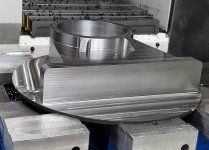Havent been by in a while sorry for the delay. There is a ball bearing pressed into a 4" aluminum disk. Thats the holder, thats all. Its intentionally kept light so it has less effect on the reamer. It is pushed by a ground flat carbide. It can float without influence, there is no center involded. Offset tailstock has no effect unless it was not parallel to the spindle. Even in that case the effect it could have would be minute. The last .025" is cut holding the holder with only my thumb and index finger. I do have the capability to measure my chambers accurately, this arrangement easily produces reamer sized holes consistently for me. I chamber at 250 rpm with cutting oil run through the bore. I dont prebore. I have some core drills for big chambers, and smaller ones the reamers cuts the whole thing. On big ones that I dont have a core drill I will ream a 1/4" then drill 1" then ream to that and drill another 1" and finish ream. No need to bore. I do get the first 3" off bore running concentric to the spindle and that is what allows this. If I indicated the muzzle and throat I would bore. .0002" at the back end of a chamber is my normal reading for runout. The bottom line for me is, check your work, if your method is producing consistent results then it is fine. I do pride myself on cutting chambers that measure to the print. It has caused me plenty of grief with dies not sizing the base enough. One of the best shooting barrels I know of, that holds current 1000yd IBS records, has a very fat chamber, threads that are probably .010" small on pitch diameter and .040" small on major diameter. Most of what we do is for our own pride.

Cloud repair, the holder you made is flat on the back and looks a little heavy. Whats the idea behind the flat? You say your going to push it with the same pusher, you mean a flat pusher? If so you have increased the surface area greatly and I see that holder having a hard time floating without influence. The ball bearing and carbide offers a small contact point with hard surfaces to minimize friction. I went back and saw your pusher. I still think the big flats will cause and issue, but the mic will let you know.


